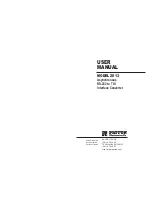
Installation
26
975-0126-01-01
Connecting the DC Cables to the Inverter/Charger
To connect the DC cables:
1. Route the DC cables from the battery bank to the inverter/charger. Observe
the “Guidelines for Routing the DC Cables” on page 25.
2. Install a DC fuse and disconnect switch or a DC circuit breaker between the
inverter/charger and the battery. They must be installed in the positive side of
the DC circuit, as close as possible to the battery.
This protects your battery and wiring in case of accidental shorting. See
Table 2 on page 11 for required fuse or breaker size. Open the DC disconnect
switch or turn off the DC circuit breaker.
3. Connect one connector on the POSITIVE (+) cable to the POSITIVE DC
terminal on the inverter/charger, as shown in Figure 7. The connector goes on
first, then the flat washer (steel), lock washer (steel), and 3/8" bolt (brass)).
4. Connect the other connector to the POSITIVE (+) terminal on the fuse or
breaker. Observe polarity carefully while completing the installation.
Use a wrench to tighten the bolt to a torque of 15–16 ft-lbs (20.4–21.7 Nm) at
the inverter/charger end. Observe the fuseholder or breaker manufacturer’s
recommendation at the other end.
5. Connect one connector on the NEGATIVE (–) cable to the NEGATIVE (–)
DC terminal on the inverter/charger, as shown in Figure 7. The connector
goes on first, then the flat washer (steel), lock washer (steel), and 3/8" bolt
(brass)).
WARNING: Fire hazard
Use only appropriately sized copper cable. Loose connections or improper connections
will overheat. Make sure the bolts supplied by Xantrex on the inverter/charger are
tightened to a torque of 15–16 ft-lbs (20.4–21.7 Nm). Torque all other connections to the
manufacturer’s specifications. Make sure the DC cable, washers, and bolt are assembled
in the order shown in Figure 7.
CAUTION: Reverse polarity damage
Before making the final DC connection or closing the DC breaker or disconnect, check
cable polarity at both the battery and the inverter/charger. Positive (+) must be connected
to positive (+). Negative (–) must be connected to negative (–).
Summary of Contents for RS2000
Page 1: ...RS2000 Sine Wave Inverter Charger Installation Guide RS2000...
Page 2: ......
Page 3: ...RS2000 Sine Wave Inverter Charger Installation Guide...
Page 8: ...iv 975 0126 01 01...
Page 16: ...xii...
Page 18: ...xiv...
Page 49: ...Installation 975 0126 01 01 31 Figure 12 Connecting the BTS Cable to Battery Temp jack...
Page 56: ...Installation 38 975 0126 01 01 Figure 15 Inverter Charger Dimensions...
Page 75: ......
















































